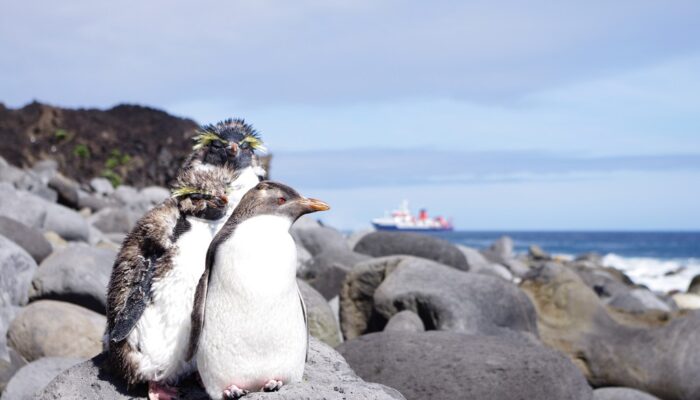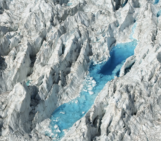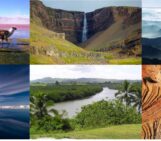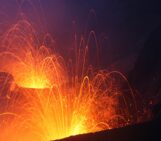
Tristan da Cunha is a remote volcanic island in the south Atlantic Ocean. In fact, it is the most remote inhabited archipelago in the world. Tristan is still volcanically active; the last time it erupted was in 1961. After the eruption, which luckily did not have any casualties, the whole population of around 260 people evacuated the island for some time, but they all returned back to the island because it was home.
I took this photo while aboard the ISOLDE research cruise associated with the GEOMAR Helmholtz Centre for Ocean Research in Germany. The ISOLDE project focuses on investigating the electromagnetic, gravimetric and seismic activity present on this little island.
There are several reasons why this area is particularly interesting for multi-disciplinary geophysical studies. First, the island is a prominent candidate for a deep-rooted hot spot. A hot spot is a volcanic region believed to be fed by mantle plumes, which bring considerable heat from deep in the Earth. Deploying ocean bottom seismometers (OBS) should help investigate the presence (or absence) of a whole-mantle plume beneath the island. Second, geophysical analysis in this region can help scientists better understand the tectonic processes involved in the extension of the South Atlantic margins and the formation of the Walvis Ridge.
In 2012, the ISOLDE (as part of the SAMPLE project) research cruise aimed to acquire a year’s worth of data on the marine electromagnetic activity, active and passive seismicity, gravity and bathymetry around Tristan da Cunha. Among others, there were 24 OBS deployed on the sea floor (around 3000-4000 m in depth). These instruments stay on the ocean bottom for one year and continuously record seismic signals.
After one year, in 2013, I joined the recovery cruise. This was my second time on a research vessel, but it was the first time I actually worked as a technical assistant on OBS.
The cruise started from Walvis Bay, a coastal town in Namibia. After a one-week transit from the harbour to the first station, we spent around seven days recovering 12 OBS around Tristan da Cunha.
The process of recovering the instruments is usually straight forward. To start, you head to the location where you first deployed the instrument, put a transducer into the water and then ping the OBS. If you get a response, you enter a code that sends an acoustic signal to release the main instrument from its steel anchor. The floating units attached to the instrument then take care of bringing the OBS back to the sea surface. Depending on the depth, it can take up to an hour until the OBS resurfaces (e.g. this is a simple calculation: 3000m deep, rising velocity of 1 m/s).
This would be a perfect recovery procedure, but you know, it rarely happens like this! After recovering half of the instruments over the course of about a week, the team got a well-deserved day off on Tristan.
Tristan da Cunha is such a small, beautiful, strange and lonely island. I was almost expecting to find a lost native tribe there, but in truth, it looked like any small town in England, with tiny gardens in front of their houses. Once we arrived at the island we had the choice between taking a touristic tour of the potato fields, where the Tristanians go in summer for holidays, or exploring the island independently.
I decided to go off to the north of the island. It was a perfect day, sunshine with no clouds in the sky, which was surprising for the South Atlantic. I wandered off past the remains of the famous 1961 eruption and the island’s own dumping place until I couldn’t go further. I arrived at a stony beach, from where I could see our ship, the M/S Merian, in the distance, anchored before the island’s coast, since our vessel was too big for Tristan’s small harbour.
I spotted the three penguins standing next to each other sun bathing. ‘Chilled guys’, I thought; and even when I drew closer to take the shot, they looked entirely relaxed and barely noticed me. It’s not like they had seen so many tourists around here! After taking the picture, I placed myself next to them (it’s surprising how smelly they are) to enjoy the view and the sun. Further down the beach, I also spotted a big mama seal and its adorable small fluffy baby. Right in front of me an orca emerged from the waters, properly trying to get to the seals. It flashed its fin before diving down again.
All in all, it was a surreal experience sitting on the remotest island on Earth surrounded by animals I usually only see in a zoo. After one wonderful day on Tristan da Cunha, we went back onboard to continue recovering the remaining OBS from the deep ocean.
By Maria Tsekhmistrenko, University of Oxford (UK)
References
OBS provided by DEPAS pool in AWI
Imaggeo is the EGU’s online open access geosciences image repository. All geoscientists (and others) can submit their photographs and videos to this repository and, since it is open access, these images can be used for free by scientists for their presentations or publications, by educators and the general public, and some images can even be used freely for commercial purposes. Photographers also retain full rights of use, as Imaggeo images are licensed and distributed by the EGU under a Creative Commons licence. Submit your photos at http://imaggeo.egu.eu/upload/.




